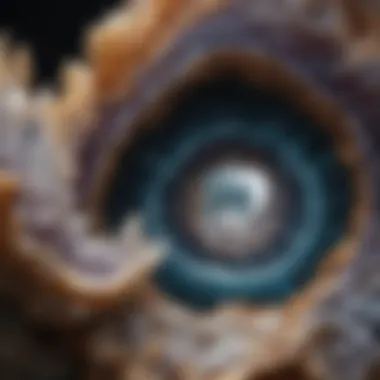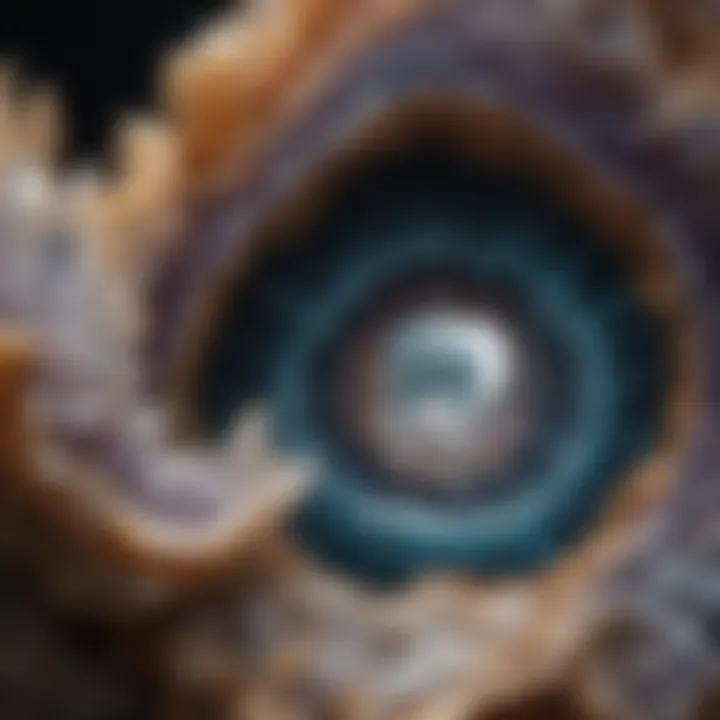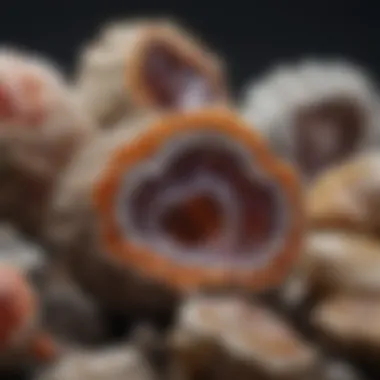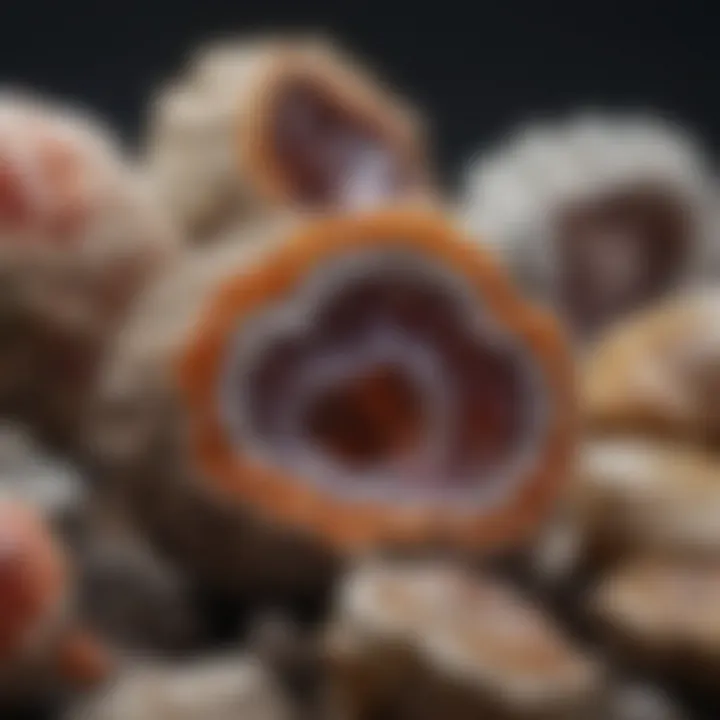Exploring Bulk Geodes: Formation and Collecting Tips


Intro
Bulk geodes have long fascinated rock collectors, geology buffs, and even casual observers with their unique allure. They are not just ordinary stones; these intriguing formations teem with potential discovery. When cracked open, they often reveal stunning interior designs, which can range from shimmering quartz crystals to vibrant colors, serving as natural art pieces.
Understanding bulk geodes requires more than just curiosity; it invites you to tap into geological processes that play out over millennia. In this exploration, we’ll dissect their origins, unravel their features, and offer practical guidance for acquiring and preserving these treasures. By marrying scientific insights and the joy of collecting, we aim to create a guide for both fledgling hobbyists and seasoned collectors.
As the quest unfolds, it's essential to keep an open mind. Every geode tells a story—it’s like a book whose pages are colorful quartz, orbs of chalcedony, and impressive calcite formations waiting to be revealed.
Featured Collectible of the Month
Overview
This month, we turn our gaze to the beautifully striking amethyst geode, a standout in both appearance and value for collectors. Often found in volcanic rocks, these geodes form through a fascinating combination of temperature, pressure, and mineral saturation. The violet hues within the crystalline structures not only captivate but also signify the unique geological conditions necessary for their formation.
Historical Significance
Amethyst has held cultural significance across different societies, from the ancient Greeks, who believed it could prevent intoxication, to the Egyptians, who used it in jewelry. In today's world, it’s revered in both spiritual realms and scientific circles. Many collectors are drawn to how historical contexts add layers to the appreciation of such natural wonders.
"Each geode is a time capsule, encapsulating nature's artistry shaped by geological forces."
Identification Techniques
Identifying bulk geodes is an essential skill for any avid collector. Knowing how to spot the right geode can mean the difference between a prized addition to one’s collection and a rock that simply doesn’t cut it.
Visual Characteristics
When on the hunt for geodes, certain traits can guide your eye:
- Exterior Texture: Look for a rough, bumpy, or pitted surface. Smooth rocks are less likely to contain cavities.
- Size and Shape: Geodes can be spherical, oval, or even irregularly shaped. Larger specimens often hold more stunning interiors.
- Color Variations: A hint of color at the cracks can signal something valuable within.
Resources for Identification
The pursuit doesn’t end with identifying the visual aspects; resources are imperative for honing your skills. Consider consulting comprehensive texts on geology, engaging with online community forums or following passionate collectors on networks like Reddit and Facebook. This can broaden your understanding and enhance your appreciation for these geological anomalies.
In particular, resources like Wikipedia and Britannica can provide foundational knowledge. With each piece of information, and each geode you examine, your expertise will surely grow.
Understanding Geodes
Understanding geodes is a significant cornerstone in grasping the broader topic covered in this article. As unique geological formations, geodes are not just aesthetically pleasing; they provide insights into the geological history of our planet. They serve as vital indicators of mineral deposits and can unveil past environmental conditions. This knowledge is essential not only for collectors interested in the geological and aesthetic value but also for researchers aiming to comprehend the Earth's processes over eons. By diving into the specifics of what geodes are, their composition, and various types, we can enhance our appreciation for their role in nature and collecting practices.
Definition and Overview
A geode is typically a hollow rock formation that often contains mineral-rich crystals. When one cracks open a geode, a mesmerizing assortment of colors and structures often greets the eye. While they can be found across various locales worldwide, their formation primarily occurs in sedimentary or volcanic environments. The hollow space within the rock is what makes geodes so captivating, as it allows for the crystallization of minerals, leading to their strikingly beautiful interiors.
Composition of Geodes
Geodes are predominantly composed of silica, which can manifest as quartz, agate, or other mineral forms. Inside these hollow cavities, multiple minerals can co-exist, and the combination may vary significantly. The mineral makeup of a geode can tell geologists a great deal about the conditions under which it was formed. For example, the unique formations of crystals inside geodes can be a direct reflection of the mineral-rich fluids that once filled the cavity.
Types of Geodes
Understanding the types of geodes enriches our perspective on their diversity and appeal:
Quartz Geodes
Quartz geodes are the most common types of geodes found in nature. They are cherished for their sparkling beauty and clarity. The crystals inside can grow in a wide range of sizes, making quartz geodes versatile collectors’ items. They are so popular due to their abundance as well as affordability, making them easy to find and collect. A unique aspect of quartz geodes is their ability to form in various colors and variations, which can be influenced by mineral impurities such as iron or manganese. The advantage lies in their widespread availability, while the disadvantage may stem from the potential for over-harvesting in specific areas.
Amethyst Geodes
Amethyst geodes have gained popularity not just for their beauty but also for their purported metaphysical properties. The rich purple color is a result of iron impurities during the crystal formation, which captures the imagination of many collectors. They offer aesthetic appeal and are often seen as a beneficial choice for holistic practices, enhancing their value in both collections and markets. Their unique color makes them a standout choice, though they can sometimes be pricier due to their desirability.
Agate Geodes
Famed for their banded appearance, agate geodes provide a different sensory experience compared to others. The variety of colors and banding patterns can be remarkable, which is why they attract collectors and jewelry makers alike. As a porous stone, agate geodes also allow for other minerals to infuse and create unique patterns. However, their appeal could diminish if one is primarily looking for sparkling crystals, as they may not have the same dramatic interior as quartz or amethyst geodes.
Other Varieties
In addition to the common quartz, amethyst, and agate geodes, there are numerous other varieties that may intrigue collectors. Varieties such as calcite, drusy, and even more exotic options exhibit unique features. For instance, calcite geodes often display crystalline structures that can create a dazzling effect when light passes through them. The downside might be their relative rarity, which could make them difficult to find or expensive. However, their distinctiveness can definitely enrich one's collection.
Geodes are not just stones; they are portals to understanding the planet's history and beauty.
Formation of Bulk Geodes
The formation of bulk geodes is an essential topic, as it lays the groundwork for understanding not only how these intriguing structures come to be but also their intricate beauty and uniqueness. Each geode tells a million-year-old story crafted by the forces of nature, and it's this very genesis that makes them appealing to both collectors and enthusiasts alike. As geological enthusiasts delve deeper, they discover that the processes behind their formation can be as captivating as the geodes themselves. Let's walk through the geological dance that leads to the birth of these magnificent formations.


Geological Processes at Play
At the heart of bulk geode formation lie several geological processes that work in concert over time. The story begins in volcanic or sedimentary rock, where empty cavities can form due to gas bubbles escaping during volcanic activity or due to the withdrawal of minerals in sedimentary layers. This makes the pocket ripe for future crystallization.
Over time, groundwater rich in minerals seeps into these cavities, carrying silica, calcite, and even iron deposits. Once inside, the chemistry of the environment becomes crucial. The temperature and the concentration of mineral-laden water can change dramatically, often causing minerals to precipitate and crystallize within the geode. This is where the real magic happens; diverse minerals can develop into a stunning array of formations, leading to the visual feast that we see today in bulk geodes.
"Nature is the ultimate artist, shaping their inner beauty through untold epochs."
Mineral Influx and Crystal Growth
As mineral-laden water enters the cavities of geodes, the influx of various elements begins to set the stage for crystal growth. Silica is often the star player, forming quartz and other variants. However, this process isn't instantaneous and involves a series of precipitations that can last for millennia.
Factors such as temperature, pressure, and the chemical environment of each cavern significantly influence how these minerals crystallize. Under ideal conditions, quartz crystals may grow in clusters, while severe environmental changes might lead to the formation of fibrous minerals or even spectacular stalactite-like structures.
The conditions within these cavities can vary greatly. For instance, if the growth environment remains stable, you'll likely see larger, well-formed crystals emerging. Conversely, fluctuating conditions can lead to more chaotic, smaller formations. Each geode's inner world is thus deeply influenced by these processes, producing a unique masterpiece that reflects its geological history.
Time Scales of Formation
The timelines involved in the formation of bulk geodes can span thousands to millions of years, which is both fascinating and humbling. The process is not a rapid one; it requires patience akin to aging a fine wine.
On one end, the initial formation of the cavities might occur within a few weeks or months due to volcanic activity. However, the filling of these cavities with minerals and the subsequent crystallization can stretch across millennia. For collectors, understanding this timescale is crucial. The older the geode, typically, the more unique the crystal formations are likely to be.
Characteristics of Bulk Geodes
Understanding the characteristics of bulk geodes is pivotal for anyone diving into the exploration and collection of these geological wonders. Their unique physical features and striking coloration not only highlight the beauty of nature but also signify various environmental conditions under which they formed. Recognizing these traits can help collectors make informed decisions, especially when curating a collection or simply enhancing one's appreciation for geological diversity.
Physical Features
Size and Shape Variations
Bulk geodes come in all shapes and sizes, reminiscent of a box of chocolates where you never quite know what you’re getting. This variety often plays a significant role in their appeal. Ranging from small fist-sized specimens to massive formations stretching over a foot in diameter, each size renders its own unique charm. A larger geode may command attention in a collection, while smaller ones often serve as charming conversation starters.
The key characteristic of size and shape variations is their informative nature on the geological processes that shaped them. Each specific size can indicate different conditions of formation. Smaller geodes might suggest quicker cooling and solidifying processes, while much larger specimens might hint at prolonged conditions favorable for crystal growth. The unique feature here is that they’re not just visually appealing; they carry narratives of their own existence.
In making a choice about which geodes to collect, size options can lead to dilemmas. Larger geodes may be more impressive but can also pose challenges in terms of storage and transportation. One must weigh the advantages against the potential inconveniences when considering size in the context of bulk geodes.
Surface Textures
Examining surface textures opens another fascinating chapter within the study of bulk geodes. The variety of textures found on their outer layers can range from smooth and shiny to rough and rugged, much like the skin of an orange. These differences arise due to factors like weathering, mineral deposits, and the manner in which the geodes formed.
A crucial aspect of surface textures is that they can provide insight into the environmental conditions prevalent during the geode's formation. For instance, a very smooth texture could indicate a geological history where the geode was polished by natural forces, while ragged surfaces may reveal a tumultuous past. The unique surface characteristics can add layers of intrigue and value to a collector's inventory.
However, collectors should be mindful of the challenges posed by irregular surfaces. They can be harder to clean and display properly, sometimes requiring tailored solutions to highlight their natural beauty without damaging their integrity.
Interior Structures
Delving into the interior structures of bulk geodes exposes a completely different world inside. The various mineral arrangements, from quartz crystals to stunning amethyst formations, paint a captivating picture of nature's creativity. One key characteristic of interior structures is their visual complexity; the interior is often brimming with crystalline formations that captivate anyone lucky enough to peek inside one of these geological time capsules.
Each unique feature within the geode can shed light on the specific mineralization processes that took place over millennia. For example, a geode with well-formed crystals suggests a long period of stable conditions conducive to crystal growth, while those with chaotic or incomplete structures may tell a tale of unpredictable environmental changes. This depth of understanding enhances the appreciation of the artistic quality found within geological formations.
Though breathtaking, these interior structures can also act as a double-edged sword. Digging deeper into exploration techniques may find collectors dealing with fragile formations or risk damaging something truly one-of-a-kind.
Coloration and Patterns
The artistry of bulk geodes doesn’t stop at their physical features; coloration and patterns create another layer of allure. Color can greatly influence a researcher or collector's interests, often dictating the market value and appeal of specific geodes. Common hues include blues, greens, and the eye-catching purples of amethyst. Understanding these colors allows enthusiasts to appreciate the science behind what makes each specimen unique.
Factors Influencing Color
Several factors influence the color seen in bulk geodes, with mineral content being a major player. The presence of trace elements can turn the ordinary into the extraordinary; for example, iron impurities can give rise to rich red and yellow tones.
This interplay of minerals and their effects on color enriches one’s understanding and enhances the value proposition of different varietals in the marketplace. A collector informed about these influences may find themselves better equipped to choose specimens that not only resonate personally but can also appreciate in value over time.
Pattern Diversity
The patterns inside and outside bulk geodes are nothing short of nature’s own artwork. These diverse patterns emerge from how minerals crystallize and settle during geode formation. Each pattern, from bold swirls to delicate lines, tells a story of geological events at play.
Not all patterns hold the same market appeal, though. Some, like the captivating banding found in agate geodes, are highly sought after and can significantly increase a geode's valuation. However, unique or irregular patterns, while potentially less marketable, can be particularly prized by collectors looking for one-of-a-kind pieces.
The broad spectrum of coloration and pattern diversity invites ongoing exploration and fascination, ensuring that the world of bulk geodes remains vibrant and engaging for collectors and geologists alike.
In summary, understanding the characteristics of bulk geodes not only enhances the appreciation of their beauty but also provides collectors and enthusiasts critical insights into the profound geological stories behind each specimen.
Exploring these elements helps not just in selection but also offers a deeper connection to the natural world, allowing one to walk away with more than just a rock but a piece of history.


Collecting Bulk Geodes
Collecting bulk geodes can be an enthralling endeavor for geology enthusiasts or anyone with a knack for natural wonders. These hollow rocks often contain stunning crystals, making them not just interesting geological specimens, but also decorative pieces. Understanding how to effectively collect geodes can open a treasure chest of opportunities for those who wish to delve into this fascinating hobby.
One of the enticing aspects of geode collecting is the thrill of the hunt. Unearthing these geological gems can feel like finding a needle in a haystack, especially when hidden beneath layers of sediment. Collectors often gain insight into the local geology, which can enhance their appreciation for the earth's processes. Moreover, this activity can serve as a therapeutic escape from the mundane routines of life, offering a chance to commune with nature while embarking on a mini-adventure.
By exploring the intricacies of geode collecting, both novice and experienced collectors can gain valuable skills to evaluate the quality of their finds, ensuring their collection remains a point of pride.
Where to Find Bulk Geodes
Finding bulk geodes requires some strategic planning, but the rewards can be immense.
Mining Locations
When it comes to mining locations, places like the Desert Hot Springs in California and the Laguna de Saladas in Argentina have become renowned hotspots for geode hunters. These areas are characterized by their rich mineral deposits where conditions are ripe for geode formation. A key characteristic of mining locations is their geological diversity, which strongly influences the variety of geodes available. However, it is crucial to ensure that mining activities are legal and environmentally sustainable.
The unique feature of many mining locations is the large scale of geode deposits, which can often result in higher yields compared to casual collecting. That said, a miner should be prepared for potential challenges such as obtaining permissions or tackling harsh terrain. Time and investment are essential here, but the potential for high-quality finds makes it worthwhile.
Site Exploration Techniques
Site exploration techniques can vastly enhance your geode hunting success. Whether it’s asking locals for tips or researching geological maps, understanding an area before you dive in can prove beneficial. A popular method involves scouting for areas where volcanic or sedimentary processes have occurred, as these climates tend to produce the most interesting geodes.
A notable element of site exploration is the use of tools like rock hammers or geological picks to safely extract the geodes from their surroundings. Even though this may seem daunting, it allows collectors to experience the excitement of the hunt on their terms. A disadvantage some face is that relying solely on information from guides may not always yield fruitful results.
Evaluating Quality
Once the hunt is over and you’re back with your treasure trove, evaluating the quality of the geodes is critical. A good evaluation process can save both heartaches and hard-earned cash.
Criteria for Selection
The criteria for selection encompasses several key parameters, including size, shape, and interior crystal formation. Larger geodes often command higher market values, but unique shapes can also add to their allure. It’s essential to look not just at the outer appearance but also at the quality of crystals inside. For instance, vibrant colors and well-formed crystals can significantly boost a geode's value.
The unique feature of quality selection is the balance between visual appeal and structural integrity; cracking or damage can diminish a geode's essence. As a rule of thumb, a collector should prioritize geodes that suggest potential aesthetic appeal to them personally over just market trends.
Potential Pitfalls in Acquisition
While the excitement of acquiring geodes is real, potential pitfalls can cloud the judgment of even the most seasoned collectors. For instance, some collectors might overlook the importance of provenance—knowing where a geode comes from can assure its authenticity and quality.
A key characteristic of potential pitfalls is the tendency for some sellers to exaggerate the beauty or rarity of their geodes, leading to poor purchasing decisions. Additionally, collectors must be wary of imitations—geodes that are altered with dyes or artificial enhancements. Hence, taking the time to research and verify the credibility of vendors and samples is fundamental.
Taking calculated steps while considering these aspects can ensure that your collection not only grows but thrives in quality.
Care and Preservation Strategies
Taking care of your bulk geodes is crucial to ensure their longevity and beauty. These natural treasures not only serve as decorative items but also hold significant geological interest. Proper care and preservation can prevent damage and help maintain their vibrant colors and intricate interior crystals. By implementing effective strategies, collectors can enjoy their geodes for years to come, highlighting their beauty and enhancing their collections.
Proper Cleaning Techniques
Keeping bulk geodes clean is paramount. Regular cleaning can prevent dirt and dust accumulation, which can dull their shine and obscure their intricate details. Here are some simple yet effective cleaning tips:
- Gentle Rinse: Use lukewarm water to carefully rinse the geode. A soft brush can help to remove stubborn particles lodged in the crevices.
- Mild Soap: For deeper cleaning, a drop of mild dish soap mixed in water can be used. Avoid any abrasive cleaners, as they may scratch or damage the surface.
- Drying: After washing, gently pat them dry with a soft cloth. It’s best not to air dry, as this can lead to water spots.
Note that not all geodes need frequent cleaning. It’s better to assess their condition before diving into a scrubbing frenzy. Excessive cleaning could lead to wear, especially on more fragile specimens.
"A little care goes a long way in preserving the allure of these stunning formations."
Storage and Display Recommendations
Storing and displaying your bulk geodes should be done with thoughtfulness and care. Here are some recommendations:
- Avoid Direct Sunlight: Prolonged exposure to direct sunlight can fade colors and damage the crystals. Display geodes in a shaded area or use UV-filtering glass if displaying them in a well-lit room.
- Use Protective Cases: When not on display, storing geodes in protective cases can prevent accidental chips or scratches. Consider using display cases made from acrylic or glass.
- Create a Stable Environment: Temperature fluctuations and humidity can affect geode integrity. Aim for a consistent, climate-controlled environment to protect them against cracking or other forms of damage.
- Labeling: For those with multiple geodes, consider labeling them. Not only does this make for a neat display, but it can also be helpful for educational purposes when sharing with others.
Ultimately, the aim is to showcase the beauty of your geodes while ensuring they're well protected. Engaging in these strategies reinforces their scientific and aesthetic value while adding depth to your collection.
Scientific Significance of Geodes
Understanding bulk geodes extends beyond their visual allure; they serve as crucial indicators in geology and facilitate insights into historical climatic and environmental conditions. Their significance lies in the information etched within their structure, revealing secrets about the Earth’s formation processes and the environmental conditions that shaped them over millennia. Through careful study, they offer a glimpse into the world that existed long before humans walked the planet, linking the past to present geological phenomena.
Geological Indicators
Geodes are often hailed as geological time capsules, encasing mineralogical information that can provide insight into the environmental conditions during their formation. These formations occur typically within volcanic or sedimentary rocks, where specific minerals precipitate, forming intricate crystal structures as the host rock weathers away. The twofold significance emerges when correlating the distribution of geodes with geological events such as volcanic activity or sediment deposition.
The presence and type of minerals within a geode can indicate the temperature and pressure conditions during its formation. For instance:


- Calcium carbonate geodes often indicate marine environments, historical sea levels, or even the presence of ancient coral reefs.
- Silica-rich geodes, like agate and quartz, can point toward previous volcanic activity, showcasing the cooling processes that allowed crystal growth.
Overall, these indicators can guide geologists in reconstructing past environments. Understanding the spatial distribution of geodes helps in mapping mineral deposits and gaining insights into potential resources. Thus, they act like breadcrumbs of geological history, leading researchers to uncover hidden layers of the Earth’s complex story.
"Geodes encapsulate not just minerals but epochs, whispering tales of Earth’s evolving landscapes and climatic shifts."
Role in Paleoenvironmental Studies
Delving into paleoenvironmental studies, geodes assume an essential role by providing data on previous ecologies and climates. The silica, calcite, and other minerals found in geodes can be analyzed to inform scientists about the conditions that prevailed at the time of their formation. For example, isotopic analyses can reveal information about:
- Past Temperature Fluctuations: Variations in oxygen isotopes in mineral crystals help reconstruct ancient temperatures, offering clues to past climate changes.
- Chemical Composition Studies: The elemental makeup found inside geodes can indicate the geochemical environment, such as salinity levels, which can reconstruct historical hydrological conditions.
- Biological Indicators: Fossilized remains or remnants found within or nearby geode formations often shed light on past life forms, aiding in the reconstruction of ecological systems and biodiversity during specific periods.
By linking the physical features of geodes to their internal chemistry, researchers can effectively tap into the geological archive these structures offer. Understanding how these natural artifacts reflect ancient environments enriches our grasp of Earth's history, informing contemporary debates regarding climate change and ecological shifts.
In summary, bulk geodes are more than just attractive geological formations; their significance extends deeply in the realms of geology and environmental science. They encapsulate conditions from epochs long gone, posing vital questions about our planet’s development and its ever-changing climate.
Aesthetic Value in Collections
Aesthetic value is often what pulls a collector into the world of bulk geodes. It's not just the scientific intrigue behind these geological formations, but also their beauty and uniqueness that can create an emotional connection. For many, geodes are not just rocks; they are art pieces carved by nature itself. When displayed correctly, they can act as stunning conversation starters, drawing attention and admiration.
Artistic Utilization
Bulk geodes can be transformed into art in myriad ways. Artists and designers often use sections of geodes to create pieces that range from small decorative items to significant installations. Whether it’s a coffee table topped with polished agate slices or wall art fashioned from colorful crystal shards, the artistic applications are far-reaching. Moreover, the natural patterns and colors found within geodes can complement various décor styles—modern minimalist, bohemian, or even rustic farmhouse themes.
Choosing geodes for artistic purposes also carries considerations. Collectors must understand which types of geodes work best in specific settings. For instance, a deep blue quartz geode might serve as a focal point in a room, while smaller, more neutral varieties can seamlessly blend into a design scheme. Some artists even apply resin over broken geodes to preserve and enhance their aesthetics, turning them into durable, eye-catching displays.
Market Trends and Valuation
The market for bulk geodes has seen an interesting evolution lately. Once confined mostly to collectors, their reaches now extend into the realms of home décor and artisanal craftsmanship. This growing demand has led to fluctuations in pricing, making it vital for collectors to stay informed about market trends.
When evaluating the value of a geode for artistic or decorative purposes, several factors influence price:
- Size: Larger geodes are often more coveted and, therefore, likely cost more.
- Color Variety: Striking color combinations or rare hues can significantly increase a geode's value.
- Crystal Quality: The clarity and growth pattern of the crystals can greatly affect desirability.
With the popularity of social media platforms like Instagram and Pinterest, more collectors are sharing their prized geode creations and displays, which in turn can drive market interest and influence valuation. Collaborative projects between artists and geode enthusiasts can also pave the way for innovative uses of these geological wonders.
Geodes aren't just about the geology; they're an intersection of nature and art that captivates collectors and creators alike.
Future Research Directions
As we move further into the 21st century, the exploration of bulk geodes continues to evolve, shedding light on new avenues for research and discovery. The significance of future research directions in geode studies cannot be overstated. Not only does it help enhance our scientific understanding of these formations, but it also aids collectors in making informed decisions about acquisition and preservation. This section explores the ongoing research in geode formation as well as technological advancements that are shaping the study of these natural wonders.
Ongoing Studies in Geode Formation
The natural world is complex, and the formation of geodes offers an incredible case study in geological processes. Recent studies focus on several key areas, including:
- Comparative Analysis: Researchers are looking into various geographical sites, comparing how different environmental factors—such as temperature and mineral availability—affect geode development. This study aims to establish a clearer understanding of how these factors interact.
- Eyewitness Accounts: Gathering first-hand reports from rock hounds and miners who share insights about their findings brings a practical perspective to the research. These accounts can often highlight trends or anomalies not captured in scientific literature.
- Field Experiments: Experimental setups in controlled conditions are being utilized to study the crystallization process. By observing seed crystals placed in artificial geode-like environments, scientists seek to simulate conditions that might contribute to their natural formation.
In essence, the exploration of ongoing studies fosters a deeper understanding of how and why bulk geodes form as they do. With these insights, rock collectors can refine their search techniques and elevate their appreciation for these geological treasures.
Technological Advancements in Analysis
The advancement of technology has brought new tools and methodologies to the forefront of geode research. Here are a couple noteworthy advancements that are reshaping the field:
- 3D Imaging and Scanning: Technologies such as X-ray computed tomography (CT) provide a non-destructive way to examine the internal structures of bulk geodes. This means that scientists can visualize the intricate network of crystals within without damaging the specimen.
- Spectroscopy: Different forms of spectroscopy help mineralogists determine the composition of the minerals found within geodes more accurately. This information is crucial not only for scientific understanding but also for collectors aiming to gauge the value and structure of their acquisitions.
By harnessing these technological advancements, researchers can offer fresh perspectives on geodes while also providing collectors essential information regarding the provenance, quality, and uniqueness of their treasures.
"Advances in technology are unlocking secrets of the natural world, making the intricate beauty of geodes more accessible and understandable than ever before."
The unfolding story of bulk geodes is filled with potential, and these future directions offer not just opportunities for academic inquiry but also a chance for collectors to engage more meaningfully with their collections. As research advances, the interplay between science and aesthetic appreciation will only grow, enriching our understanding of these captivating natural phenomena.
Culmination
In summarizing the multifaceted nature of bulk geodes, it is essential to appreciate how these natural wonders capture the imagination of collectors and scientists alike. The allure of bulk geodes arises not just from their aesthetic appeal but also from the intricate processes that lead to their formation and their role in understanding geological history. Recognizing the importance of bulk geodes can enhance one’s appreciation for geology while also fostering a more informed collector base.
Summary of Key Points
Throughout this exploration, several key points emerge:
- Definition and Formation: Bulk geodes are definable geological structures that develop over extended periods through mineral-rich water seeping into cavities of rocks. The unique geological processes result in a myriad of shapes and interior structures.
- Characteristics: Their size and surface textures can vary significantly, alongside an array of colors and patterns influenced by mineral content and environmental conditions. This diversity makes them a fascinating subject for study and collection.
- Collecting Insights: Understanding where to find bulk geodes and the criteria for evaluating their quality are pivotal for both hobbyists and serious collectors. Proper techniques in care and preservation ensure these geodes are maintained and appreciated over time.
- Scientific and Aesthetic Relevance: They serve as important indicators in geological studies and play a role in paleoenvironmental research, offering insights into past ecological conditions.
Implications for Collectors and Researchers
The implications of this knowledge are manifold:
- Informed Collecting: With a deeper understanding of bulk geodes, collectors can make educated decisions in sourcing and collecting, ultimately enhancing their collections with quality specimens.
- Research Opportunities: For researchers, bulk geodes represent natural archives that could provide new insights into mineral formation and geological changes over millennia. Ongoing studies are vital, especially given advancements in analytical technologies that could uncover details about the formation processes.
- Community Engagement and Knowledge Sharing: As more collectors and researchers delve into the world of bulk geodes, there is a growing community eager to share knowledge, tips, and experiences. Platforms like Reddit and Facebook offer spaces for enthusiasts to connect, learn from one another, and promote their findings.
In essence, bulk geodes present a unique intersection of beauty, science, and community. Engaging with this field can be incredibly enriching, fostering a greater understanding and appreciation for the geological processes that create these striking formations.



